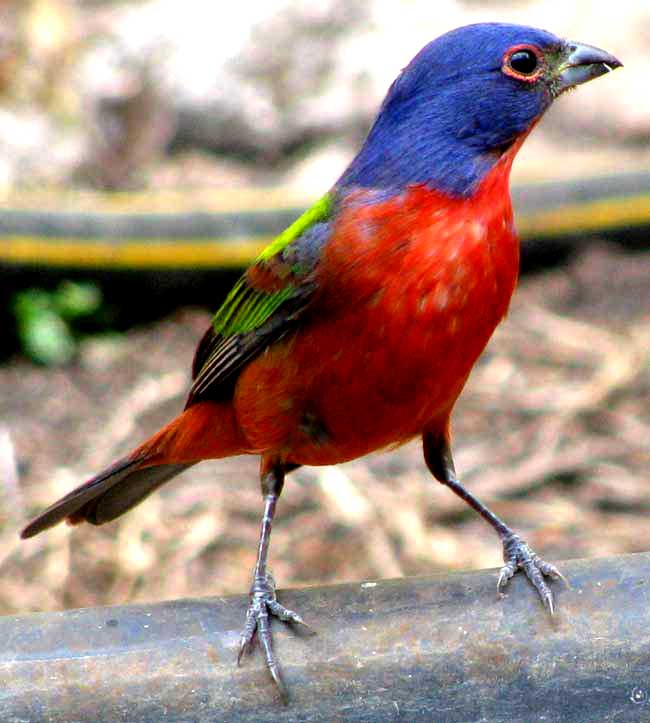
Excerpts from Jim Conrad's
Naturalist Newsletter

from the December 26, 2010 Newsletter issued from
Hacienda Chichen Resort beside Chichén Itzá ruins, central Yucatán, MÉXICO
SEVEN-COLORED BUNTING
Surely the most colorful of all songbirds is the Painted Bunting. The other day as I sat
reading next to my black, plastic-trough birdbath one landed on the trough not six feet
away, and I was ready, as shown above.
In Spanish the bird's name is Colorín Sietecolores, or "Seven-colored Bunting," though contrarians might count more or fewer than seven colors. The Painted Bunting's binomial is PASSERINA CIRIS, with Passerina being the same genus in which the Indigo, Lazuli and other Northern-breeding buntings are found.
As with Indigo Buntings, Painted Buntings are only winter residents in the Yucatan. Comes spring they'll migrate north to nest, and then for colorful birds we'll have to settle for motmots, trogons and parrots.
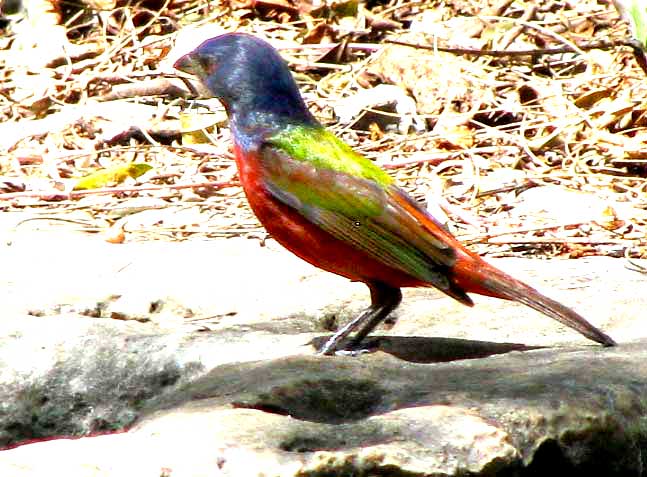
from the March 21, 2010 Newsletter issued from
Hacienda Chichen Resort beside Chichén Itzá ruins, central Yucatán, MÉXICO
AT THE HALTÚN WATERING HOLE
With the dry season bearing down hard now, every day I fill the haltunes, or natural
watering holes in limestone rock, and all day long, every day, there's a continual parade
of birds who arrive, land in branches above the haltunes, look around and look some more,
then finally descend to drink their fill. Despite the heat often I throw an old, brown
poncho over myself for camouflage and sit with my camera about 20 feet away, and wait.
Surely the most colorful bird visiting the haltunes is the Painted Bunting, PASSERINA CIRIS, shown above.
Painted Buntings are migrants, thus they are winter visitors to the Yucatán, as they are all the way south to Panama. During the northern summer they range no farther south than north-central Mexico. Here they're not common, but also not very rare. Often they mix in small flocks with other seed-eating species, and sometimes you see such a flock blowing in like so many fluttery leaves on the dry afternoon wind.
from the January 2, 2011 Newsletter issued from
Hacienda Chichen Resort beside Chichén Itzá ruins, central Yucatán, MÉXICO
JUVENILE PAINTED BUNTING
This week, in the little plastic trough in front of the hut, a juvenile came to take a
bath. You can see how drastically different the juvenile looks below:
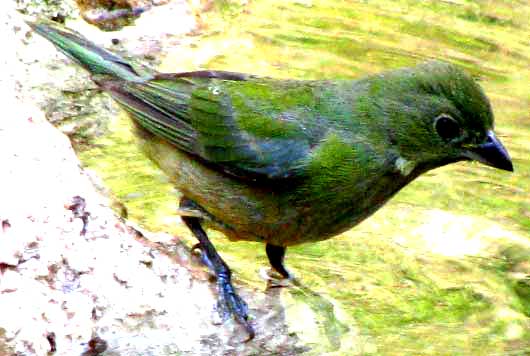
Juveniles are very similar to females of the species. I know that this is a juvenile because Howell says that the juvenile's underparts often bear indistinct, dusky streaks, and this individual's streaked chest is apparent. Also the juvenile's underparts are described as "washed pale buffy brown" while those of females are yellowish -- and this one's breast is brownish.
Especially in brilliant morning sunlight the upper parts of both females and juvenile birds show up strikingly greenish. In the picture, that white spot below the bird's nape must just be an anomalous white feather.
from the April 28, 2013 Newsletter issued from the Frio
Canyon Nature Education Center in northern Uvalde County, southwestern Texas, on the
southern border of the Edwards Plateau; elevation ~1750m (~5750 ft); N29.62°, W99.86°; USA
RAINBOW BIRD
Once again, in the sow thistles below my kitchen window, a marvelous bird turned up, this
one maybe the most colorful of all our species, shown below:

That's the male Painted Bunting. A female perched not far away with her yellowish-green back, as seen below:
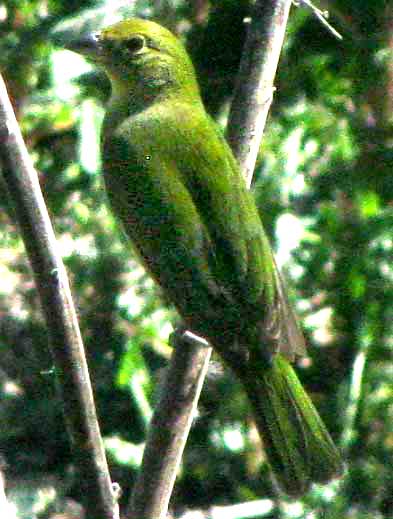
When such colorful little beings turn up so quietly tending their affairs you just have to wonder about the spiritual impulse evolving life forward, and admit that there must be more to the impulse than mere "urge for diversity" in accordance with basic Darwinian principles. There must be a certain gaiety in the impulse, a glad panache, an eagerness to laugh and dance and spew poetry and song.
I stood at the kitchen window thinking this, and I also thought how glad I was that I hadn't succumbed to "community standards" suggesting that I cut my sow thistle so that monocultured, evenly cut, water wasting grass can grow there. For months this sow thistle has been a blessing, first by providing me with so many delicious meals, then later by feeding such a rainbow of birds. You can know sow thistle better on our page for the species at http://www.backyardnature.net/n/h/sonchus.htm.
Birders in most of North America never have the pleasure of seeing Painted Buntings below their kitchen windows. The species nests in deep brush along the US Gulf Coast and in the south-central states as far north as Kansas. They overwinter in southern Florida, southern Mexico and most of Central America.
from the May 12, 2002 Newsletter issued from the woods
near Natchez, Mississippi
PAINTED BUNTING
I've been hoping I would spot a Painted Bunting during my counts because I wanted
to tell you about them. The mature males of this species are the most colorful of all US
birds. They seem to have been painted brightly by children who don't know how "real
birds" are colored. Red breast and rump, blue head, greenish back, a mixture of red,
green and blue in the wings... The first time you see one, it seems artificial. Of course,
being so beautiful, their song is just a weak warble with nothing notable distinguishing
it. Painted Buntings don't occur as far north as Kentucky so I never saw one until I came
here the first time during the early 80s.
The hippie community was still together then and I was a visiting writer gathering information for a story. I was in the old slave kitchen with Mark the gay cook, who wore a red bandana over his head. The kitchen smelled of woodsmoke, simmering tomato-based stew and basil. An August rainstorm was ending, the air was fresh and cool, and late-afternoon sunlight burst through the door with such unexpected sharpness and clarity that I looked outside to see what was going on.
The wet clematis vine out front was sparkling as if light were bursting from its leaves and stems, and a mature male Painted Bunting was perched in it inspecting a large blue flower. It was a moment of such exquisite beauty that if I should have to die now, that fleeting image is one of a handful from my whole life I'd want to recall
I have said "mature male" above when speaking of the rainbow-colored plumage. That's because some males don't get their brilliant colors until their third year, though by the second they can sing and acquire a mate. This is what I saw Friday, a male in his second year, looking like a drab, greenish-yellow female.
But that spotting was enough for me to tell you about him, and to recall that first sighting some twenty years ago here at Laurel Hill.
from the February 14, 2016 Newsletter issued from Hacienda Chichen Resort beside Chichén Itzá Ruins,
central Yucatán MÉXICO
PAINTED BUNTING EATING PIGEONBERRIES
Through a crack in the hut's wall next to my computer desk, I photographed a Painted
Bunting feeding on Pigeonberries, as shown below:
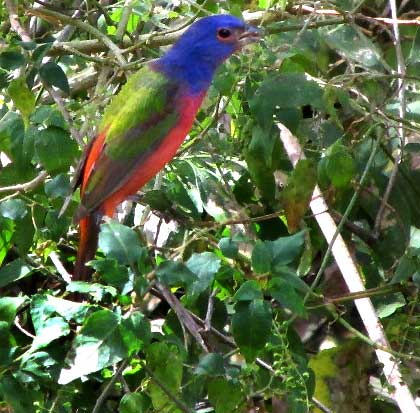
However, often it's hard to find field documentation of animals doing things other than being photographed in one or another places. So, here we're going on record declaring that one food Painted Buntings eat in the Yucatan is Pigeonberry, Rivinia humilis, a member of the Pokeweed Family, and there's a lot of Pigeonberry here, right now its red fruits being eaten by a variety of birds. Our Pigeonberry page is at http://www.backyardnature.net/yucatan/pigeonby.htm.